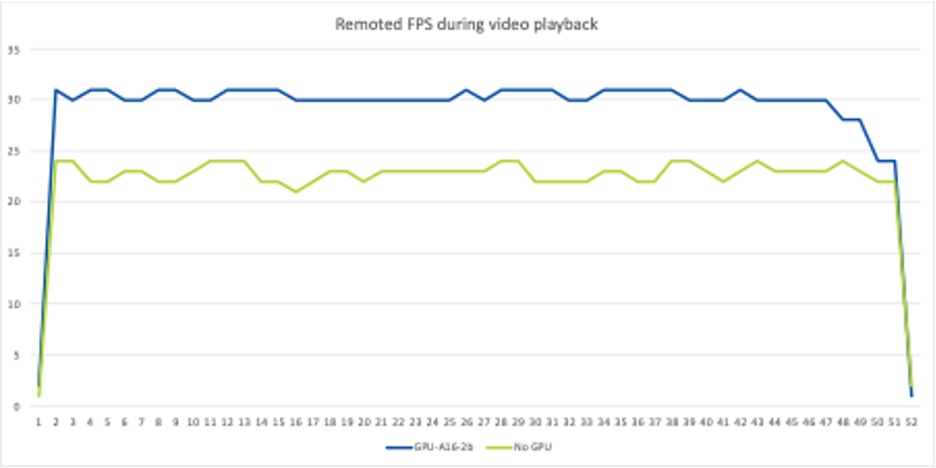

The results are in! With NVIDIA’s newest GPUs designed for virtual desktops and applications, you can address a wider variety of use cases than you could ever before. In our independent testing using the NVIDIA® nVector benchmarking tool, we saw that a single A16 GPU could support 64 virtual desktops, each with 2vCPUs and 1GB framebuffer profiles, per node. With two A16 cards installed we were able to scale to 128, albeit we would recommend a high-performance CPU when scaling to 128 desktops. In a minimal Nutanix® configuration of a three node cluster that equates to 384 users per cluster, all having access to 1GB of framebuffer profile!
Now that any scalability limitations are a distant memory, how about performance? We tested that as well using NVIDIA’s nVector using the “knowledge worker” workload. We discovered that using the A16 GPUs in that same configuration yielded over a 30% improvement in frames per second (FPS) and latency approaching 1/20 of a second. When we scaled the performance testing to 128 VMs, that is when the A16 GPU really came through and delivered. As you can see in figure 1 once we attained a steady state without the GPUs the framerate did not reach 25 fps. However, adding a vGPU increased the framerate by approximately 20%.
Frame rate during video playback

Figure 1
With scalability and performance delivered in one package, let’s take a closer look at the use cases that this solution addresses. As mentioned, the testing was intentionally performed with the knowledge work profile, which is the broadest definition of a user. Historically we can all agree that the power user, with CAD and CAM applications, was assured to get the best experience when paired with a GPU. The knowledge worker today has more resource-intensive applications, even when those applications are delivered through a web browser. Rich media delivery is becoming the de facto standard for SaaS applications, so much so that by default Google’s Chrome® browser starts up looking for a GPU to offload the processing of web-based applications. Hence our knowledge workers now more closely resemble our power users, and our task workers resemble the knowledge workers of the past.
Prior to the ability to provision GPUs at scale, disaster recovery (DR) for these use cases traditionally needed careful thought and planning, with complicated workflows that impacted RPOs and RTOs. Using the Nutanix AHV® hypervisor and supported NVIDIA GPUs you can failover persistent user workloads with an attached vGPU to another Nutanix cluster just like any other VM workload, with no additional tools or management controls required.
With this data, we must rethink the best way to deliver the best experience to our users. No longer can we design an environment where GPUs are relegated to an exclusive few or are the constraining factor in scalability. With the A16 GPUs, we can confidently allocate GPUs to a broader group of users in our environment that will help them to deliver higher productivity.
—-------------
Testing environment:
NX-3155G-G8
CPU: 2x Gold 6354 CPU @ 3.0
Memory: 1.5TB
Disks: 6x SSD
GPU: 2x NVIDIA A16
Targets and client VMs: Windows® 10 OS
Broker: Citrix Virtual Apps and Desktops 7 - 1912 U4
Benchmark tool:
NVIDIA nVector using the knowledge worker workload
Tests:
64 VMs - 2 vCPUs - 1GB vGPU
64 VMs - 4 vCPUs - 2GB vGPU
128 VMs - 2 vCPUs - 1GB vGPU
64 VMs - 2 vCPUs - no vGPU
64 VMs - 4 vCPUs - no vGPU
128 VMs - 2 vCPUs - no vGPU